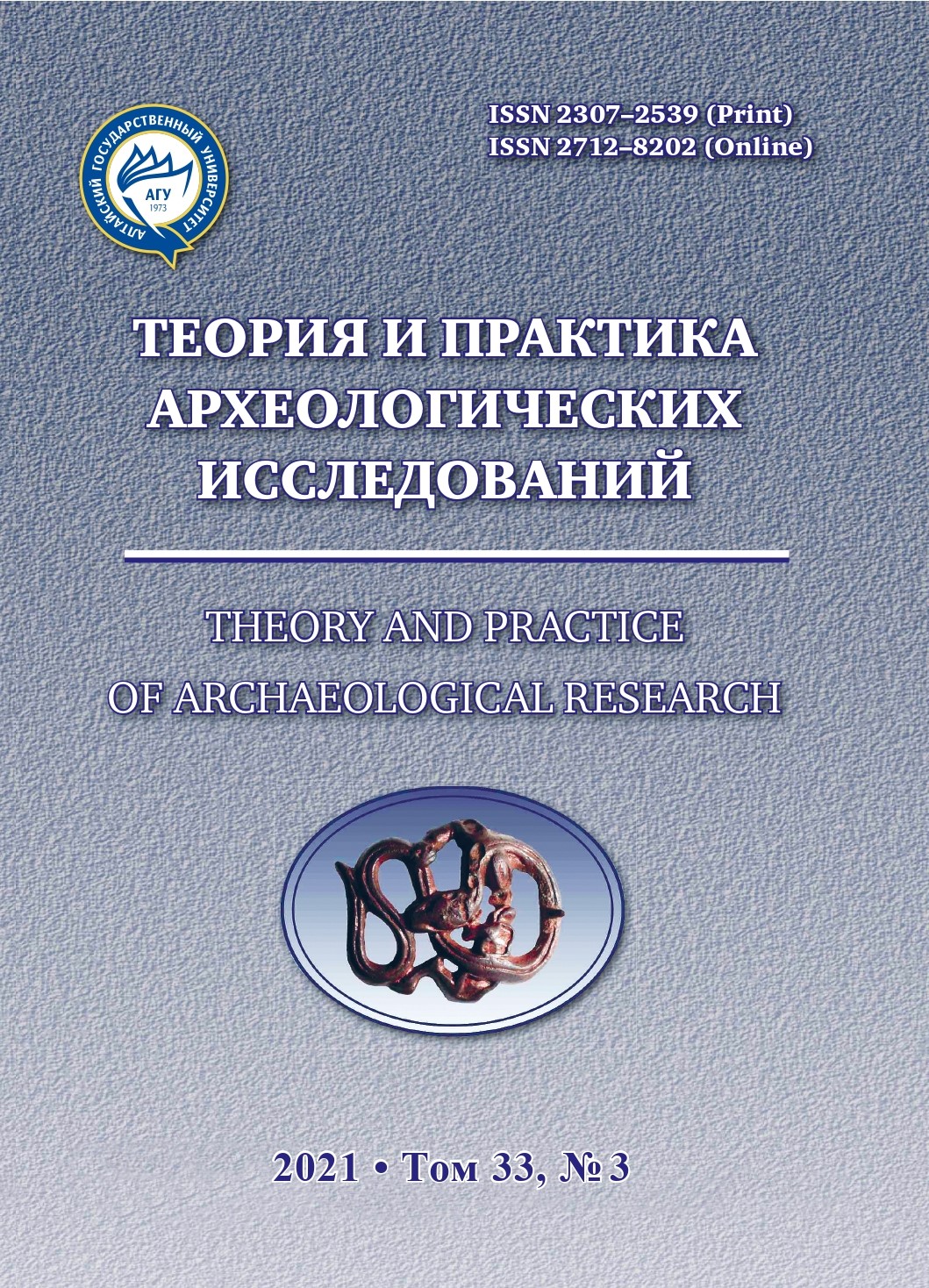ARCHITECTURAL TRADITIONS OF THE TRANS-URALS FOREST-STEPPE POPULATION IN THE EARLY IRON AGE
Abstract
By the beginning of the Early Iron Age, under the influence of climatic and socio-political factors, the population of the forest-steppe had several traditions of housing construction. First of all, they were expressed in the variety of types of dwellings and techniques of their construction. During the Transition period from the Bronze Age to the Iron Age, the population of the Itkul culture had small above-ground framed buildings. The Baitovo population that replaced them at the beginning of the Early Iron Age has already recorded two types of buildings — above-ground framed buildings and and dwellings with cribbed walls. In the Gorokhovo-Sargat time, an unprecedented flourishing of house construction is marked. The Gorokhovo population has buildings with the ‘zaplot’ walls (i.e., built using vertical wooden posts with a lengthwise recess in which timber logs or panels are inserted), and dwellings with cribbed walls, frame-and-pillar structure are widely distributed. The presence of certain standards and traditions in architecture can be traced. The population of the Sargat culture built at least five types of dwellings: insulated and light cone-shaped, those built in the frame-and-pillar technique, dwellings with ‘zaplot’ walls, and cribbed dwellings. A feature that has clearly manifested itself in Sargat housing construction is the articulation of several chambers, different in structure and functions, into one household complex.
Downloads
References
Berlina S. V. K voprosu o tipah zhilishсh naseleniya rannego zheleznogo veka zapadnosibirskoj lesostepi (po materialam sargatskoj kul’tury) [On the Question of the Types of Dwellings of the Population of the Early Iron Age of the West Siberian Forest-Steppe (based on the materials of the Sargat culture)]. Rossijskaya arheologiya [Russian Archaeology]. 2009. № 2. Pp. 44–56. (In Russ.).
Berlina S. V. Zhilishyha gorohovskoj kul’tury Zaural’ya [Dwellings of Gorokhov Culture of Trans-Urals]. Vestnik arheologii, antropologii i etnografii [Bulletin of Archaeology, Anthropology and Ethnography]. 2019. № 3 (46). Pp. 62–74. (In Russ.). DOI: 10.20874/2071‑0437‑2019‑46‑3‑062‑074
Berlina S. V., Zimina O. Y. Domostroitel’stvo naseleniya itkul’skoj kul’tury v podtaezhnomlesostepnom Zaural’e [Housing Construction of the Population of the Itkul Culture in the Subtaiga-forest-steppe Trans-Urals]. Vestnik arheologii, antropologii i etnografii [Bulletin of Archaeology, Anthropology and Ethnography]. 2020. № 3 (50). Pp. 61–73. (In Russ.). DOI.10.20874/2071‑0437‑2020‑50‑3‑5
Habdulina M. K. Gorodishhe Ak-Tau kak arhitekturnyj kompleks [Ak-Tau Settlement as an Architectural Complex]. Znaniya i navyki ural’skogo naseleniya v drevnosti i srednevekov’e [Knowledge and Skills of the Ural Population in Antiquity and the Middle Ages]. Ekaterinburg: Nauka, 1993. Pp. 112–143. (In Russ.)
Habdulina M. K. Stepnoe Priishim’e v epohu rannego zheleza [Steppe Priishimye in the Early Iron Age]. Alma-Ata: Rakurs, 1994. 170 р. (In Russ.)
Koryakova L. N. Poseleniya sargatskoj kul’tury [Settlements of the Sargat Culture]. Vestnik arheologii Urala [Bulletin of the Archaeology of the Urals]. 1984. № 17. Pp. 61–79. (In Russ.)
Koryakova L. N., Dyer M. I., Kovrigin A. A., Sharapova S. V., Berseneva N. A., Panteleeva S. E., Razhev D. I., Kurto P., Hanks B., Efimova E. G., Kazdym A. A., Mikryukova O. V. Sreda, kul’tura i obshchestvo lesostepnogo Zaural’ya vo vtoroj polovine I tys. do n.e. (po materialam Pavlinovskogo arheologicheskogo kompleksa) [Environment, Culture and Society of the Forest-steppe Trans-Urals in the Second Half of the 1st Millennium BC (based on the materials of the Pavlinovsky archaeological complex)]. Ekaterinburg ; Surgut : Magellan, 2009. 298 p. (In Russ.)
Matveeva N. P. Sargatskaya kul’tura na Crednem Tobole. [Sargat Culture on the Middle Tobol]. Novosibirsk : Nauka, 1993. 175 p. (In Russ.)
Matveeva N. P. Social’no-ekonomicheskie struktury naseleniya Zapadnoj Sibiri v rannem zheleznom veke (lesostepnaja i podtaezhnaja zony) [Socio-economic Structures of the Population of Western Siberia in the Early Iron Age (forest-steppe and subtaiga zones)]. Novosibirsk : Nauka, 2000. 299 p. (In Russ.)
Molodin V. I. Ekologicheskij “stress” na rubezhe II–I tys. do n.e. i ego vliyanie na etnokul’turnye i social’no-ekonomicheskie processy u narodov Zapadnoi Sibiri [Ecological «Stress» at the Turn of the 2nd–1st Millennium BC and Its Impact on Ethnocultural and Socio-Economic Processes among the Peoples of Western Siberia]. Kul’tura kak sistema v istoricheskom kontekste: opyt zapadno-sibirskih arheologo-etnograficheskih soveshchanij [Culture as a System in a Historical Context: the Experience of West Siberian Archaeological and Ethnographic Meetings]. Tomsk : Agraf-Press, 2010. Pp. 22–24. (In Russ.)
Ocherki kul’turogeneza narodov Zapadnoj Sibiri [Essays on the Cultural Genesis of the Peoples of Western Siberia]. Volume 1. Book 2. Tomsk : Izd-vo Tomskogo gosudarstvennogo universitetа, 1994. 286 p. (In Russ.)
Sal’nikov K. V. Arheologicheskie issledovaniya v Kurganskoj i Chelyabinskoj oblastyah [Archaeological Research in the Kurgan and Chelyabinsk Regions]. Kratkie soobshcheniya o dokladah i polevyh issledovaniyah Instituta istorii material’noj kul’tury [Brief Reports on the Reports and Field Studies of the Institute of the History of Material Culture]. 1951. Issue XXXVII. Pp. 88–96. (In Russ.)
Sal’nikov K. V. Gorodishhe Chudaki Chelyabinskoj oblasti po raskopkam 1947 g. [The Ancient Settlement of the Chudaks of the Chelyabinsk Region according to the Excavations of 1947]. Sovetskaya arheologiya [Soviet Archaeology]. 1947. Volume IX. Pp. 221–238. (In Russ.)
Tsembalyuk S. I. Harakteristika poselenij i zhilishch baitovskoj kul’tury [Characteristics of Settlements and Dwellings of the Baitovo Culture]. Vestnik arheologii, antropologii i etnografii [Bulletin of Archaeology, Anthropology and Ethnography]. 2009. №10. Pp. 57–65 (In Russ.)
Tsembalyuk S. I., Berlina S. V. Kompleks rannego zheleznogo veka gorodishcha Lihachevskoe v Priishim’e [The Complex of the Early Iron Age Settlement of Likhachevskoye in Priishimye]. Vestnik arheologii, antropologii i jetnografii [Bulletin of Archaeology, Anthropology and Ethnography]. 2014. №3(26). Pp. 55–65 (In Russ.).
Zah V. A., Tsembalyuk S. I. Baitovskij kompleks poseleniya Chepkul’ 8b [Baitovsky Complex of the Settlement of Chepkul 8b]. Vestnik arheologii, antropologii i etnografii [Bulletin of Archaeology, Anthropology and Ethnography]. 2009. №10. Pp. 65–74. (In Russ.)
Zimina O. Y., Zah V. A. Nizhnee Pritobol’e na rubezhe bronzovogo i zheleznogo vekov [The Lower Tributary Region at the Turn of the Bronze and Iron Ages]. Novosibirsk : Nauka, 2009. 232 p. (In Russ.)
Theory and Practice of Archaeological Research is a golden publisher, as we allow self-archiving, but most importantly we are fully transparent about your rights.
Authors may present and discuss their findings ahead of publication: at biological or scientific conferences, on preprint servers, in public databases, and in blogs, wikis, tweets, and other informal communication channels.
Theory and Practice of Archaeological Research allows authors to deposit manuscripts (currently under review or those for intended submission to ABS) in non-commercial, pre-print servers such as ArXiv.
Authors who publish with this journal agree to the following terms:
- Authors retain copyright and grant the journal right of first publication with the work simultaneously licensed under a Creative Commons Attribution License (CC BY 4.0) that allows others to share the work with an acknowledgement of the work's authorship and initial publication in this journal.
- Authors are able to enter into separate, additional contractual arrangements for the non-exclusive distribution of the journal's published version of the work (e.g., post it to an institutional repository or publish it in a book), with an acknowledgement of its initial publication in this journal.
- Authors are permitted and encouraged to post their work online (e.g., in institutional repositories or on their website) prior to and during the submission process, as it can lead to productive exchanges, as well as earlier and greater citation of published work (See The Effect of Open Access).







2.jpg)






